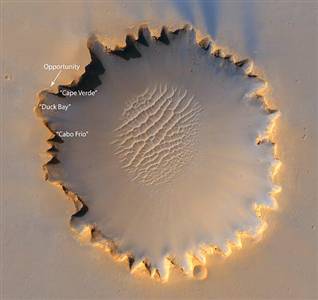Rover reaches Victoria - safe driving needed.

NASA’s newest Mars orbiter has reached at the rim of the Red Planet’s massive Victoria Crater.Appearing almost as a shiny boulder, Opportunity’s and its camera-mast shadow can easily be seen in the image by NASA’s MRO.
It just another great image which is taken from a distance of 200 million miles.
Victoria Crater is large enough to fit up to five football stadiums inside and is the biggest Martian crater to be visited by NASA’s red planet rovers.
Rover - Help in Exploration
The rovers together have taken upto approximately 160,000 images of the red planet. They have been a great help in studying the planet.Opportunity has spent 21 Earth months exploring the Meridiani Planum region of Mars. The rover’s robotic twin Spirit rolled across its own Gusev Crater landing site, scaled one of the region’s Columbia Hills and clambered down the other side.
This is the deepest thing studied on this planet. Certainly, it uncovers the secrets and provides us information about the conditions and composition of rocks in the early years. Early estimates pin Victoria Crater at somewhere between 10 million and 100 million years old, but the rocks within the depression themselves are likely much older – as in a few billion years in age.
Opportunity has already found evidence that subsurface water once soaked rocks at Meridiani Planum based on studies at Eagle Crater and the larger Endurance Crater, both of which are dwarfed by Victoria’s size.A complete trip around the crater’s 1.5-mile (2.5-kilometer) rim would take up to nine months.
Very Careful Drive
The interesting and the most difficult of all is to keep the rover safe from diving into the crater. Mission controllers have to find a safe path to enter and then exist from this crater. Everything needs to be done carefully.
Opportunity is now into the 960th Martian day of a mission that was initially planned to span just 90 sols, the term for days on Mars. Now pushing more than 10 times its expected lifetime, Opportunity could fail at any moment.
Click to see Victoria Crater


1 comment:
Ya, scientists need to keep a strict eye on the rover activities.
Post a Comment